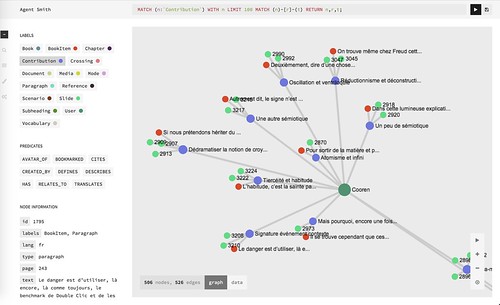Modeling a Philosophical Inquiry: from MySQL to a graph database - FOSDEM 2016 (Saturday 30)
We are very happy to offer a second piece of good news this month (after the article published in Visible Language), coming this time from the AIME dev team members (Paul Girard, Guillaume Plique, Daniele Guido). They are invited to give a talk at FOSDEM 2016 (Free and open source software developers' European meeting):
Modeling a Philosophical Inquiry: from MySQL to a graph database The short story of a long refactoring process
Saturday 30 January 2016
Room: AW1.126
Day: Saturday
Start: 12:45
End: 13:35
Abstract:
Bruno Latour wrote a book about philosophy (an inquiry into modes of existence). He decided that the paper book was no place for the numerous footnotes, documentation or glossary, instead giving access to all this information surrounding the book through a web application which would present itself as a reading companion. He also offered to the community of readers to submit their contributions to his inquiry by writing new documents to be added to the platform.
The first version of our web application was built on PHP Yiii and MySQL on the server side. This soon proved to be a nightmare to maintain because of the ultra-relational nature of our data.
We refactored it completely to use node.js and Neo4J. We went from a tree system with internal links modelized inside a relational database to a graph of paragraphs included into documents, subchapters etc. all sharing links between them.
On the way, we've learned Neo4J thoroughly, from graph data modeling to cypher tricks and developed our custom cypher query graphical monitor using sigma.js in order to check our data trans-modeling consistency.
During this journey, we've stumbled upon data model questions: ordered links, sub items grouping necessity, data output constraints from Neo4J, and finally the limitations of Neo4J community edition.
Finally we feel much more confortable as developers in our new system. Reasoning about our data has become much easier and, moreover, our users are also happier since the platform's performance has never been better.
Our intention is, therefore, to share our experience with the community:
- our application's data needs
- our shift from a MySQL data model to a Neo4J graph model
- our feedbacks in using a graph database and more precisely Neo4J including our custom admin tool Agent Smith
- a very quick description of the admin tools we built to let the researchers write or modify contents (a markdown web editor)
The research has received funding from the European Research Council under the European Union’s Seventh Framework Programme (FP7/2007-2013) / erc Grant ‘IDEAS’ 2010 n° 269567”
Slides of the presentation available here:
http://medialab.github.io/aime-core/#/
Authors:
Guillaume Plique
A graduate student from Sciences-Po Lille and Waseda University, Guillaume Plique now offers the médialab his backend development skills as well as his profile in social sciences. He has been working since June 2013 on several projects such as IPCC mapping, AIME and develops scrapers aimed at social sciences researchers.
https://github.com/Yomguithereal
Paul Girard
Paul Girard is an Information Technology engineer specialized in driving collaborations between technology and non-technical domains. He graduated from the cultural industry engineering specialisation in Université de Technologie de Compiègne in 2004 where he studied the relationships between digital technologies and society and the mechanisms of collaborations. He worked in the research laboratories federation CITU (Paris 1 and Paris 8 universities) from 2005 to 2009 where he participated in research and creation projects, collaborations between artists and engineers working with interactivity, digital pictures, virtual and augmented reality. He joined the médialab laboratory at Sciences Po at its foundation during the spring of 2009, as the digital manager of this digital research laboratory dedicated to fostering the use of digital methods and tools in Social Sciences. Since then he oversees the technical direction of the many research projects as collaborations between social sciences, knowledge engineering and information design. His present research fields are digital methods for social sciences, exploratory data analysis and enhanced publication though digital story telling.
https://github.com/paulgirard
Daniele Guido
Daniel Guido is a visual interaction designer interested in data mining applications, text analysis and network tools. He collaborates with researchers in History and Social Science, designers and engineer to conceive and develop digital tools for the humanities. He recently joined the DIgital Humanities lab at CVCE team in Luxembourg after several years working at the Sciences-Po Medialab team in Paris, where he was engaged in the FORCCAST project (forccast.hypotheses.org) and in the AIME project (modesofexistence.org)
https://github.com/danieleguido
External links:
https://fosdem.org/2016/schedule/event/graphprocessingmysqltograph/

